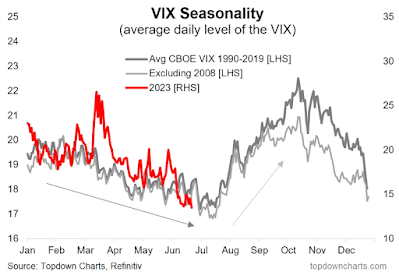*** denotes well-worth reading in full at source (even if excerpted extensively here)
Economic and Market Fare:
.... This lagged nature of inflation is part of the process and a big reason why core inflation won’t bottom until a year or so after the recession is over. The parts of inflation that have the ability to move in real-time have shown a marked change since the first half of 2022.
As the rent/shelter component slowly trickles down, core inflation will drift lower, revealing monetary policy to be increasingly tight. ........
Today, the Real Fed Funds Rate is back to the same level but will continue to increase from here even if the Fed doesn’t raise rates anymore due to the decline in Core CPI from the lagged shelter data.
The economy is unlikely to withstand a higher level of real interest rates compared to five years ago when the debt and demographic profile, both domestically and globally, are materially worse.
Nevertheless, the Real Rate will rise and increase pressure on the economy at a time when recessionary conditions are proliferating through a wider basket of data. ......
....
The trends in retail sales, Fed regional surveys and claims are recessionary, adding to the case that after a pause the next move from the Fed will be a cut, rather than another hike. Monthly or weekly data are fine if you want some trading volatility, but not helpful when trying to discern the path of the economy. ....
...



........ There have been increasing concerns about the depth of the CRE downturn. Goldman Sachs chief credit strategist Lotfi Karoui told clients last month that "the most accurate portrayal of current market conditions" is data via the Green Street Commercial Property Price Index, which indicates trouble ahead. Karoui explained, "Green Street indicating a 25% year-over-year drop in office property values."

The implacable trade deficits run by the United States since the late 1970s have been, and continue to be, costly to the American economy. For decades, the implicit and explicit subsidies to manufacturers that have driven surpluses in countries like China and Germany have caused global manufacturing to migrate from deficit countries to surplus countries, and from none more so than the largest deficit country by far, the United States. What is more, as I wrote in “Bad Trade,” published by American Compass, American trade deficits force Americans to choose between higher unemployment, more household debt, or greater fiscal deficits. They have helped drive the surge in American debt for nearly five decades.
It is important to understand the U.S. trade deficit within the context of global trade. In spite of the World Trade Organization (WTO) and other global entities designed to enforce free trade, the world is experiencing one of the most mercantilist periods in history.
Conventional wisdom holds that countries that run persistent trade surpluses do so because their populations are especially hard-working and thrifty and their manufacturers especially efficient at production. This is simply not true. The reward for successful exporting would not be trade surpluses, but rather the ability to import ever greater amounts of foreign goods in exchange for those exports at constantly improving terms of trade.
In a well-functioning trade environment, countries would not be able to run large, persistent surpluses or deficits, mainly because these surpluses or deficits would force changes in their respective economies that would automatically eliminate them. The fact that we live in a world with the largest, most persistent trade imbalances in history is more than sufficient proof that mercantilist policies in individual economies are preventing the necessary adjustments that make free trade beneficial for the world. ......
If a Chinese property market falls in the forest, could it not make too much of a noise?
........... It almost seems like what we’re talking about here isn’t a recovery at all, but rather a long-term fall for one of the Chinese economy’s most vital drivers with little chance of policy support to help turn things around. And, if so, that’s a pretty meaningful development!
Charts:
1:
...
(not just) for the ESG crowd:
And the Fossil Fuel Industry is Off its Meds
























No comments:
Post a Comment